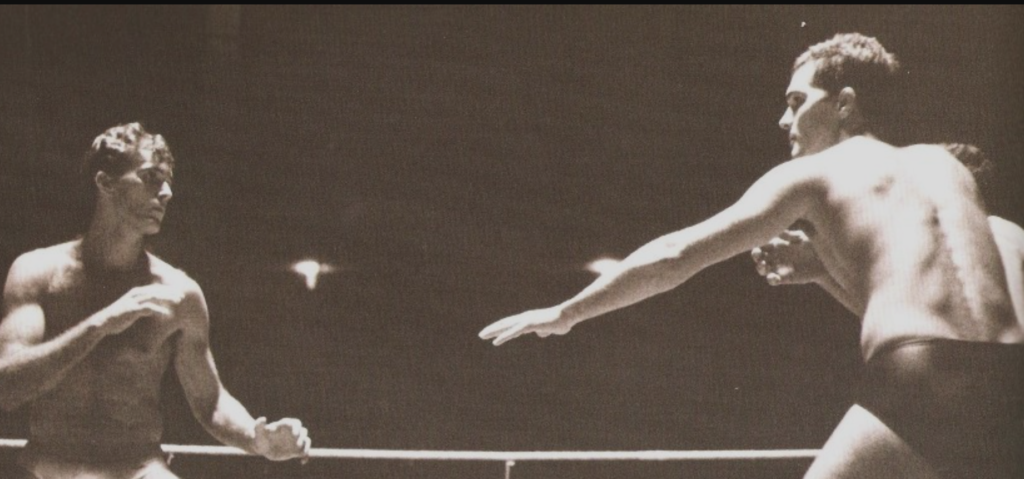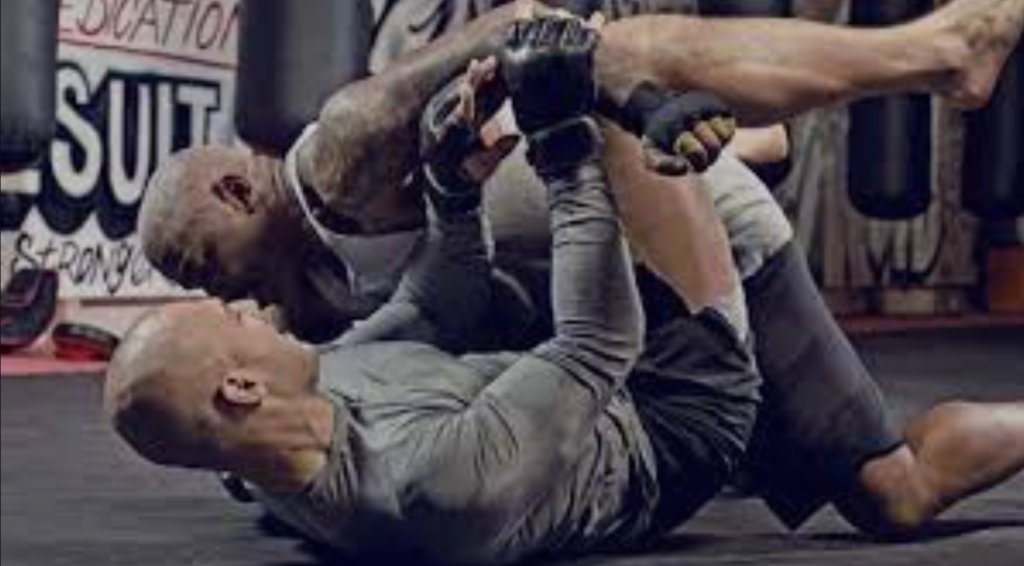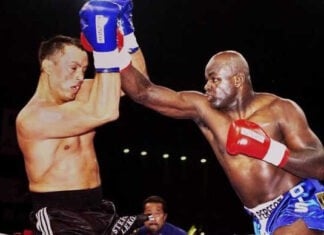
Vale Tudo, which means “anything goes” in Portuguese, is a combat sport that originated in Brazil in the early 20th century. This no-holds-barred style of fighting involves striking, grappling, and submissions and has a controversial history due to its brutal and often violent nature. Vale Tudo was initially seen as a way to settle disputes and determine the best fighter, but as the sport gained popularity, it became more regulated, and rules were introduced.
The Early Days of Vale Tudo
Vale Tudo, which translates to “anything goes,” was a form of combat sport that emerged in Brazil in the early 20th century. The origins of Vale Tudo can be traced back to the Gracie family. Early matches were initially used to showcase the effectiveness of Brazilian Jiu-Jitsu against other fighting styles.
No-Holds-Barred Fights
In its early days, Vale Tudo was a no-holds-barred form of combat sport, which meant that anything goes. There were no rules, weight classes, or time limits, and fighters could use any technique they wanted to defeat their opponents. Fighters were also not required to wear protective gear, making the sport even more dangerous. This lack of regulation led to many injuries, and even deaths, which resulted in the sport being banned in Brazil for a period of time.
Vale Tudo was a brutal sport that involved striking, grappling, and submissions. Fighters would often engage in violent brawls that could last for hours, with no clear winner emerging. The violent nature of the sport attracted many spectators, who would bet on the outcome of matches. However, the sport’s brutality also led to many controversies, with critics arguing that it promoted violence and had no place in a civilized society.
Controversies Surrounding Vale Tudo
Vale Tudo, originating in Brazil, has been a source of controversy since its inception. Critics have raised concerns about the safety of fighters, the questionable ethics of the sport, and its impact on society as a whole.
Safety Concerns
One of the biggest controversies surrounding Vale Tudo is the safety of fighters. In its early days, the sport had no rules, weight classes, or protective gear, which resulted in many injuries and even deaths. Even with the introduction of rules and regulations, this combat art remains a dangerous sport, with fighters at risk of serious injuries such as concussions, broken bones, and torn ligaments. Some people argue that the sport promotes mindless, chaotic violence and should be banned.
The Questionable Ethics of Vale Tudo
Another controversy surrounding Vale Tudo is the questionable ethics of the sport. Matches usually involved violent brawls, with fighters engaging in brutal and often bloody fights. The sport was been criticized for promoting violence and having no place in a civilized society. Some argue that the sport dehumanizes fighters and turns them into objects of entertainment.
The Impact of Vale Tudo on Society
The impact of Vale Tudo on society is another source of controversy. Some argue that the sport promotes violence and has a negative influence on young people. Others believe that it promotes discipline, respect, and physical fitness.
Despite the controversies surrounding it, the sport has had a significant impact on the world of combat sports, leading to the evolution of mixed martial arts and the creation of organizations such as the UFC.
Vale Tudo’s Evolution
Vale Tudo has come a long way since its early days as a no-holds-barred combat sport. The introduction of rules and regulations has transformed the sport into a more regulated and safer form of combat.
The Introduction Of Rules
One of the biggest changes to Vale Tudo was the introduction of rules and regulations. In the early days of the sport, anything went, and fighters could use any technique or move to defeat their opponents. However, with the introduction of rules, fighters were limited in the techniques they could use, and protective gear was introduced to reduce the risk of serious injuries.
The introduction of rules and regulations transformed Vale Tudo into a more regulated and safer sport.
The Growth Of Vale Tudo As A Sport
As Vale Tudo became more regulated, its popularity grew, both in Brazil and around the world. With the introduction of weight classes and protective gear, matches became more accessible to a wider audience, and the sport’s fan base began to grow.
In the 1990s, Vale Tudo gained even more popularity with the creation of organizations such as the International Vale Tudo Championship and the Pride Fighting Championships.
Vale Tudo’s Influence on MMA
Vale Tudo’s influence on mixed martial arts cannot be overstated. Many of the techniques used in modern MMA, such as striking, grappling, and ground fighting, and most importantly, the integration of them all, were first used in Vale Tudo matches.
Popular fighters coming form this early combat sport, such as Royce Gracie and Marco Ruas later helped to popularize Brazilian Jiu-Jitsu and revolutionize the world of MMA. The rules and regulations introduced in Vale Tudo’s matches also laid the groundwork for the early versions of what we now know as the modern MMA ruleset.
Vale Tudo Rules
Speaking of rules, Vale Tudo began as a no-holds-barred fighting sport, with virtually no rules or regulations in place. This led to a lot of criticism, particularly from those who were concerned about the safety of the fighters. Over time, however, rules began to be introduced to make the sport safer and more fair.
One of the key developments in this regard was the establishment of the Unified Rules of Vale Tudo, which were first introduced in the 1990s. These rules introduced a range of safety measures, such as weight classes and mandatory gloves, and banned certain techniques, such as headbutts and groin strikes.
The introduction of rules helped to make Vale Tudo more mainstream and acceptable as a sport, but it also sparked controversy among some traditionalists who felt that the sport was losing its original rawness and brutality.
Despite this, the rules have continued to evolve over time, with many promotions now having their own specific regulations in place. This has helped to create a more consistent and standardized approach to Vale Tudo, which has allowed it to continue to grow in popularity around the world.
Vale Tudo vs MMA
MMA) and Vale Tudo share a similar history and have many similarities in terms of rules and techniques. However, there are also some significant differences between the two that have led to some friction over the years.
The Similarities And Differences Between Vale Tudo And MMA
Both Vale Tudo and MMA are full-contact combat sports that allow fighters to use a wide range of techniques, including striking, grappling, and submissions.
However, Vale Tudo typically involves fewer rules and restrictions than MMA, with no weight classes, no gloves, and few time limits. In contrast, MMA has evolved to include a standardized set of rules and regulations that aim to ensure the safety of the fighters and promote fair competition.
The Evolution Оf MMA From Vale Tudo
MMA has its roots in Vale Tudo, which was hugely popular in Brazil in the 1920s and 1930s. As the sport spread around the world, different organizations and promoters began to develop their own sets of rules and regulations, leading to the emergence of modern MMA. The Pride Fighting Championship was the thing that greatly popularized MMA on the basis set by Vale Tudo, as the Japanese were fascinated by the no-holds-barred approach.
The UFc, despite emerging initially as the American adaptation of Vale Tude and existing before Pride, did not catch on outside of Brazil due to the lack of rules. PRid, however, helped the UFC re-shape and re-organize into the leading promotion it is nowadays.
The Current State of Vale Tudo and MMA Competitions
Today, Vale Tudo competitions are relatively rare, and the sport has largely been eclipsed by MMA. However, there are still some practitioners of the sport who continue to promote the sport and compete in non-regulated events.
MMA, on the other hand, has exploded in popularity and is one of the fastest-growing and most-followed sports in the world. MMA events are now held all over the world, and the sport has produced some of the biggest stars in combat sports history.
Vale Tudo vs BJJ
Vale Tudo and Brazilian Jiu-Jitsu both share a similar history and a portion of the techniques. While they are similar in many ways, there are some notable differences between the two combat sports, as well as a complicated relationship.
Vale Tudo and BJJ share a common history as they both originated in Brazil. In the early days, Brazilian fighters who practiced various martial arts styles such as Judo, Boxing, and Capoeira would often compete against each other.
However, BJJ, quickly became a dominant force in Vale Tudo as they were able to defeat opponents from other styles with their ground fighting techniques. Eventually, Jiu-Jitsu took over the popularity of Vale Tudo mainly due to the fact it was organized as a sport and not a blood sport.
BJJ athletes in Brazil nowadays look down on Vale Tudo’s fighters as not technical fighters that rely on strength and chance a lot more than refined technique, timing and tactics.
The Future Of Vale Tudo
As Vale Tudo continues to evolve, however slowly and isolated, it faces a number of challenges, but also exciting opportunities. In this section, we take a closer look at the state of the sport in modern times, the challenges facing the sport, and its prospects for the future.
Vale Tudo remains a popular combat sport in Brazil, where it originated, as well as in other parts of the world. In Brazil, it continues to be practiced both professionally and as a recreational sport. However, the sport has struggled to gain mainstream acceptance in some parts of the world, due to its violent nature and lack of regulation.
One of the biggest challenges it faces is the need for greater regulation and safety measures. While the sport has come a long way in terms of introducing rules and protective gear, there is still more that can be done to reduce the risk of serious injury to fighters.
Another challenge is the need to improve the public perception of the sport. Many people still associate the sport with brutality and violence, which can make it difficult to attract sponsors and mainstream media coverage.
Despite the challenges facing Vale Tudo, there are also exciting opportunities for the sport in the future. With the right regulations and safety measures in place, Vale Tudo could potentially become a popular and respected combat sport around the world.
Conclusion
Vale Tudo is a sport with a rich and controversial history. From its origins as a no-holds-barred fight to the introduction of rules and its evolution into MMA, this combat art has faced numerous controversies including safety concerns and questionable ethics. It has also had a significant impact on society and the world of combat sports. Understanding the controversies surrounding Vale Tudo is essential to appreciate the sport’s history fully.
















































